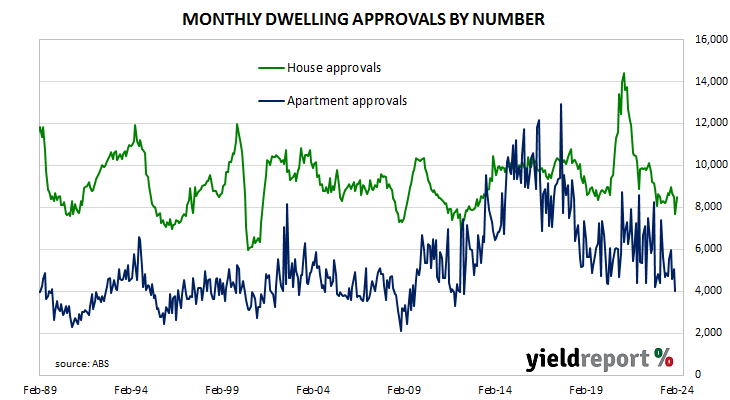Home approval numbers down 1.9% in February, contrasts with expected gain; 5.8% lower than February 2023; Westpac: approvals making another leg lower; ACGB yields up; rate-cut expectations soften; Westpac: data suggests ‘front end’ of construction pipeline shrinking materially; house approvals up 10.5%, apartments down 20.8%; non-residential approvals down 16.0% in dollar terms, residential alterations down 0.1%.
Building approvals for dwellings, that is apartments and houses, headed south after mid-2018. As an indicator of investor confidence, falling approvals had presented a worrying signal, not just for the building sector but for the overall economy. However, approval figures from late-2019 and the early months of 2020 painted a picture of a recovery taking place, even as late as April of that year. Subsequent months’ figures then trended sharply upwards before reversing course and falling back through 2021, 2022 and 2023.
The Australian Bureau of Statistics has released the latest figures from February and they show total residential approvals fell by 1.9% over the month on a seasonally-adjusted basis. The result contrasted with the 3.0% gain which had been generally expected but the fall was not as great as January’s 2.5% loss after revisions. Total approvals fell by 5.8% on an annual basis, in contrast with the previous month’s revised figure of 4.1%. Monthly growth rates are often volatile.
This marks a third monthly fall in a row, suggesting approvals are making another leg lower after bumping around a weak level through most of last year,” said Westpac senior economist Matthew Hassan. “That said, the detail is less conclusive.”
Commonwealth Government bond yields rose on the day, generally contrasting with overnight movements of US Treasury yields. By the close of business, the 3-year ACGB yield had added 3bps to 3.71%, the 10-year had gained 4bps to 4.19% while the 20-year yield finished 6bps higher at 4.60%.
In the cash futures market, expectations regarding rate cuts in the next twelve months softened. At the end of the day, contracts implied the cash rate would remain close to the current rate for the next few months and average 4.305% through May and 4.29% in June. However, August contracts implied a 4.215% average cash rate, November contracts implied 4.07%, while February contract implied 3.935%, 39bps less than the current rate.
“Overall, the February building approvals data suggests the ‘front end’ of the construction pipeline is shrinking materially, although the extent of the down-trend in dwelling construction is unclear,” Hassan added. “At current levels, annual new dwelling completions, which came in at just over 170,000 last year, will be tracking steadily lower towards 155,000 as the roughly 50,000 of backlogged projects clear.”
Approvals for new houses rose by 10.5% over the month, in contrast with January’s 9.5% loss after revisions. On a 12-month basis, house approvals were 1.2% lower than they were in February 2023, up from January’s comparable figure of -4.4%.
Apartment approval figures are usually a lot more volatile and February approvals for this category dropped by 20.8% after a 10.6% gain in January. The 12-month growth rate fell from January’s revised rate of 20.5% to -14.3%.
Non-residential approvals decreased by 16.0% in dollar terms over the month and were 32.8% lower on an annual basis. Figures in this segment also tend to be rather volatile.
Residential alteration approvals slipped by 0.1% in dollar terms over the month and were 2.2% lower than in February 2023.



